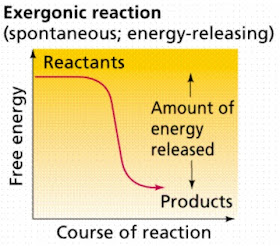 |
| Exorgenic reaction |
Exergonic reactions are spontaneous chemical reactions in which the products are at a lower energy level than the reactants; these reactions release energy. Endergonic reactions are nonspontaneous chemical reactions in which the products are at a higher energy level than the reactants; these reactions consume energy.
The primary source of energy for life on the earth is the sun,which is the energy source for photosynthesis: the biological process that transforms radiant energy into chemical energy. Chemical energy is stored in biological molecules, which can then be used as the fuel to provide an organism’s energy needs.
Such biological molecules include sugars (or carbohydrates), proteins, and lipids (or fats). In the reactions of metabolism, many types of molecules are synthesized (anabolism), and many are broken down (catabolism). Changes in energy content occur in all these reactions.
  |
Bioenergetics is the science that studies the description of the basic mechanisms that govern the transformation and use of energy by organisms. A basic tenet of bioenergetics is that no chemical reaction can be 100 percent energy-efficient. In other words, in all reactions there is some transfer of energy, but some of it is always lost in the form of heat.
The energy (often measured in calories) contained in the molecular structure of a compound is called Gibbs free energy (after Josiah Willard Gibbs, 1839-1903, who founded the discipline of physical science) and is the energy available to perform work.
The difference between the free energy of the products and the free energy of the reactants in a chemical reaction is called the change in free energy and is fundamental in determining if a reaction can occur spontaneously. If the change in free energy is negative, energy is released, and the free energy content is less in the products than in the reactants.
Such reactions are considered exergonic. On the other hand, if the change in free energy is positive, the reaction is considered endergonic and is non-spontaneous (that is, endergonic reactions require a source of energy to enable them to occur).
Energy Coupling
Many cellular reactions are endergonic and can not occur spontaneously. Nevertheless, cells can facilitate endergonic reactions using the energy released from other exergonic reactions, a process called energy coupling.
As an example, consider a common endergonic reaction in plants in which glucose and fructose are joined together to make sucrose. To enable this reaction to take place, it is coupled with a series of other exergonic reactions as follows:
glucose + adenosine triphosphate (ATP) → glucose-p + ADP
fructose + ATP → fructose-p + adenosine diphosphate (ADP)
glucose-p + fructose-p → sucrose + 2 Pi(inorganic phosphate)
Therefore, although producing sucrose from glucose and fructose is an endergonic reaction, all three of the foregoing reactions are exergonic. This is representative of the way cells facilitate endergonic reactions.
   |
Role of ATP
The principal molecule involved in providing the energy for endergonic cellular reactions to take place is adenosine triphosphate, or ATP, the same molecule used in the example above.
ATP is typically produced by joining an inorganic phosphate to adenosine diphosphate (ADP), which is an endergonic reaction. This, too, represents a characteristic of chemical reactions: If a reaction is exergonic in one direction, it will be endergonic in the opposite direction.
Thus, the breakdown of ATP is exergonic, while the production of ATP is endergonic. The energy for production of most of the ATP in plant cells comes from the light reactions of photosynthesis and the electron transport system in the mitochondria.
The enigma is why ATP, and not any other molecule, is used. Although no complete justification is available, there are several points that support its significance.
First, there is the high stability of the ATPmolecule at the physiological pH (around 7.4) toward hydrolysis and decomposition in the absence of an enzyme catalyst. This stability allows ATP to be stored in the cell until needed. Second, ATP is one of the molecules (a nucleotide) that is used in synthesis ofDNA.
Finally, the magnitude of the change in free energy involved in the ATP-ADP transformation is of an amount useful for driving many of the endergonic reactions in the cell. As a result, it can play the role of an intermediate quite easily.
